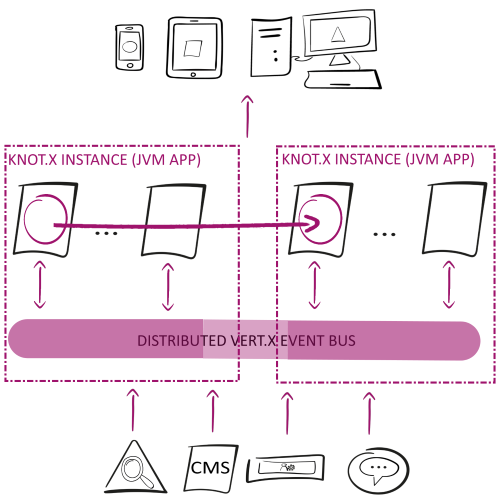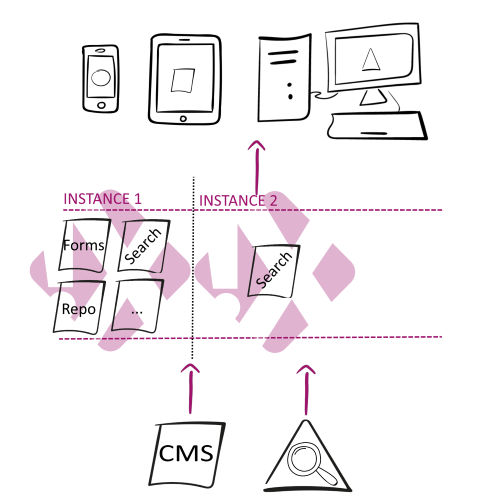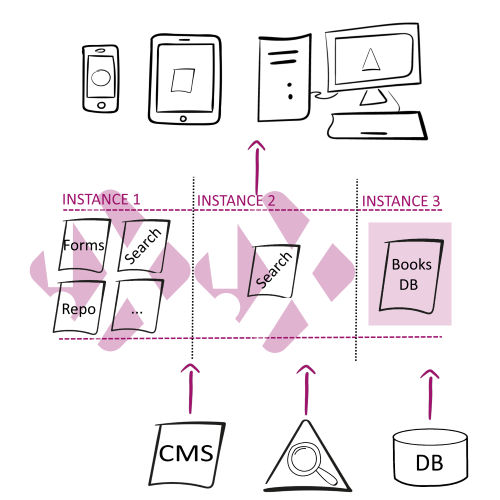Overview
In this tutorial, we’re going to show how Knot.x can be easily scaled and expanded. We explain how to start Knot.x in cluster mode and allow different Knot.x instances to communicate with each other using an event bus.
This article uses code examples and configurations presented at GeeCON 2017.
What you’re going to learn:
- How to scale Knot.x platform using cluster mode
- How to expand Knot.x features by running new modules on dedicated Knot.x instance
The full GeeCON 2017 demo script is available here.
Prerequisites
Clone a tutorials github repository and open a conferences/geecon2017 directory:
git clone https://github.com/Knotx/knotx-tutorials.git
cd knotx-tutorials/conferences/geecon2017Next download Knot.x standalone fat jar
and place it in the app folder under both instance-1 and instance-2 directories.
Event Bus
Before we start our Knot.x instances we want to give you some details about Knot.x architecture to help you with understanding what will happen in a few minutes.
So basically in terms of an architecture Knot.x is a bunch of isolated modules. Those modules have defined contracts so they are easy to test, upgrade or exchange.

Those modules communicate via Event Bus. It is a lightweight messaging system delivered by Vert.x allowing different modules, or different application instances to communicate in a loosely coupled way.
Scalability
Let's now explain the case we use in our example.

Knot.x instance-1 contains Knot.x Core modules and one additional Search module (for GeeCON demo
purposes we used Service Knot for Search).
Our Search module connects to Google Books API and provides books details based on a query.
The step by step module configuration is described in Hello Rest Service
tutorial.
Knot.x instance-2 contains only the Search module. It is exactly the same module like the instance-1.
We use instance-2 to scale the Search module.
So let's run instance-1 and instance-2 in a cluster mode:
$ cd instance-1
$ java -Dvertx.disableDnsResolver=true -Dlogback.configurationFile=knotx-standalone-1.0.1.logback.xml -cp "app/*" io.knotx.launcher.LogbackLauncher -conf knotx-standalone-1.0.1.json -cluster$ cd instance-2
$ java -Dvertx.disableDnsResolver=true -Dlogback.configurationFile=knotx-standalone-1.0.1.logback.xml -cp "app/*" io.knotx.launcher.LogbackLauncher -conf knotx-standalone-1.0.1.json -clusterYou may check the second console log and see that cluster is working:
Deployed e25c5446-0a19-4b76-87c3-cc1cec07e869 [knotx:io.knotx.ServiceKnot]
Deployed e900595f-2522-4279-82c8-a49b304c1895 [knotx:io.knotx.HttpServiceAdapter]
...
Members [2] {
Member [192.168.56.1]:5701
Member [192.168.56.1]:5702 this
}Now you can open a Books Page in your
favorite browser to see the console. Every time you refresh the page, Vert.x dispatches the search
request between instance-1 and instance-2. So Vert.x gives us load balancing for free.
Extendability
Knot.x provides well-defined extension points like Knots and Adapters. They allow to easily extend Knot.x Core features with project specific requirements.
In this example we connect to a database to fetch some information about books authors. But our database is not available via HTTP so we need to connect with it directly. The image blow presents what we want to achieve.

Before the next steps checkout and build Adapt Service Without Web API
using Maven. Place the custom-service-adapter-1.0.1-fat.jar it in the instance-3/app folder.
Then prepare the DB according to this tutorial.
To create tables with data, use the script provided in the instance-3/db folder of this tutorial.
Now run instance-3 with BooksDbAdapter in cluster mode (assuming instance-1 and instance-2 are still running):
$ cd instance-3
$ java -Dvertx.disableDnsResolver=true -Dlogback.configurationFile=knotx-standalone-1.0.1.logback.xml -cp "app/*" io.knotx.launcher.LogbackLauncher -conf knotx-standalone-1.0.1.json -clusterOpen DB Books Page and see details about authors.
Finally we used the same cluster mechanism as in the scalability example to dynamically deploy the database datasource.
